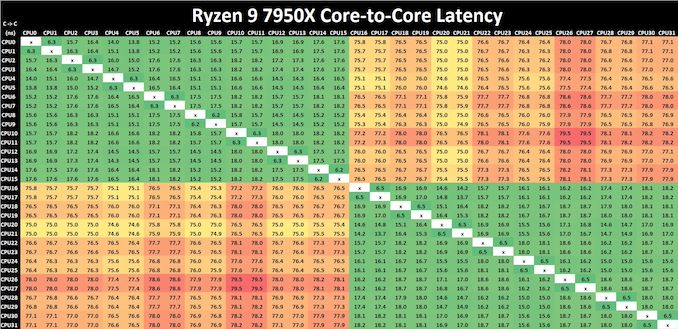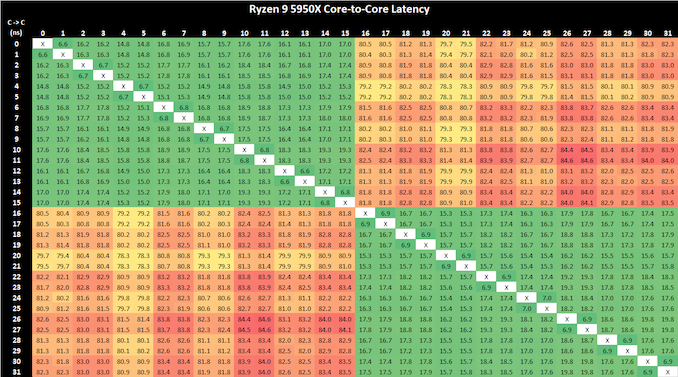AMD Zen 4 Ryzen 9 7950X and Ryzen 5 7600X Review: Retaking The High-End
by Ryan Smith & Gavin Bonshor on September 26, 2022 9:00 AM ESTCore-to-Core Latency
As the core count of modern CPUs is growing, we are reaching a time when the time to access each core from a different core is no longer a constant. Even before the advent of heterogeneous SoC designs, processors built on large rings or meshes can have different latencies to access the nearest core compared to the furthest core. This rings true especially in multi-socket server environments.
But modern CPUs, even desktop and consumer CPUs, can have variable access latency to get to another core. For example, in the first generation Threadripper CPUs, we had four chips on the package, each with 8 threads, and each with a different core-to-core latency depending on if it was on-die or off-die. This gets more complex with products like Lakefield, which has two different communication buses depending on which core is talking to which.
If you are a regular reader of AnandTech’s CPU reviews, you will recognize our Core-to-Core latency test. It’s a great way to show exactly how groups of cores are laid out on the silicon. This is a custom in-house test, and we know there are competing tests out there, but we feel ours is the most accurate to how quick an access between two cores can happen.

Click to enlarge (lots of cores and threads = lots of core pairings)
Comparing core to core latencies from Zen 4 (7950X) and Zen 3 (5950X), both are using a two CCX 8-core chiplet design, which is a marked improvement over the four CCX 16-core design featured on the Zen 2 microarchitecture, the Ryzen 9 3950X. The inter-core latencies within the L3 cache range from between 15 ns and 19 ns. The inter-core latencies between different cores within different parts of the CCD show a larger latency penalty of up to 79.5 ns, which is something AMD should work on going forward, but it's an overall improvement in cross CCX latencies compared to Zen 3. Any gain is still a gain.
Even though AMD has opted for a newer and more 'efficient' IOD which is based on TSMC's 6 nm node. It is around the same size physically as the previous AMD IOD on Zen 3 manufactured on GlobalFoundries 12 nm node, but with a much larger transistor count. Within the IOD is the newly integrated RDNA 2 graphics, although this isn't typical iGPU in the sense that an APU is. A lot of the room on the IOD is made up of the DDR5 memory controller or IMC, as well as the chips PCIe 5.0 lanes, and of course, connects to the logic through its primary interconnect named Infinity Fabric. All of these variables play a part on power, latency, and operation.

AMD Ryzen 9 5950X Core-to-Core Latency results
It's actually astounding how similar the latency performance of the Ryzen 9 7950X (Zen 4) is when compared directly to the Ryzen 9 5950X (Zen 3), despite being on the new 5 nm TSMC manufacturing process. Even with a change of IOD, but with the same interconnect, the inter-core latencies within the Ryzen 9 7950X are great in terms of cores within the same core complex; latency does degrade when pairing up with a core in another chiplet, but this works and AMD's Ryzen 5000 series proved that the overall penalty performance is negatable.










205 Comments
View All Comments
TelstarTOS - Monday, September 26, 2022 - link
Too few games tested, no 1400p tests, no 7700X tested. Waiting for more ReplyGavin Bonshor - Monday, September 26, 2022 - link
AMD only sampled us with the 7950X and 7600X. We'll hopefully get our 7700X in the near future. In regards to game testing, you'll much more/better titles in our next CPU review as we move to our 2023 suite. This will come into effect in our next CPU review. Replyrarson - Wednesday, September 28, 2022 - link
1400p? Replymeacupla - Monday, September 26, 2022 - link
What I am seeing is 5800X3D being a beastWhich is why I really look forward to 7x00X3D chips Reply
Gavin Bonshor - Monday, September 26, 2022 - link
Me too! ReplyFreckledTrout - Monday, September 26, 2022 - link
Those should be really strong. Its probably AMD's answer to Intel's 13th gen. Replykwohlt - Monday, September 26, 2022 - link
7000 3D is more so AMD's answer to MeteorLake, as both are expected sometime in 2023. Zen 4 is sometime in 2024 and will go up against ArrowLake.Vanilla 7000 and RaptorLake are direct competitors. Reply
kwohlt - Monday, September 26, 2022 - link
****Zen 5 Replynandnandnand - Monday, September 26, 2022 - link
https://www.theverge.com/23294064/intel-deny-meteo...Meteor Lake will come out in late 2023, if at all. 7000X3D sounds like it could launch in January. So 7000X3D will have free reign for the better part of a year. Reply
Lothyr - Monday, September 26, 2022 - link
Same, not to mention that it should give firmware time to stabilize, time to DDR5 to get cheaper, time for PCIe5 SSD to be released, etc. So I guess 6 months-ish before I upgrade (we'll see what Intel comes up with as well). Reply